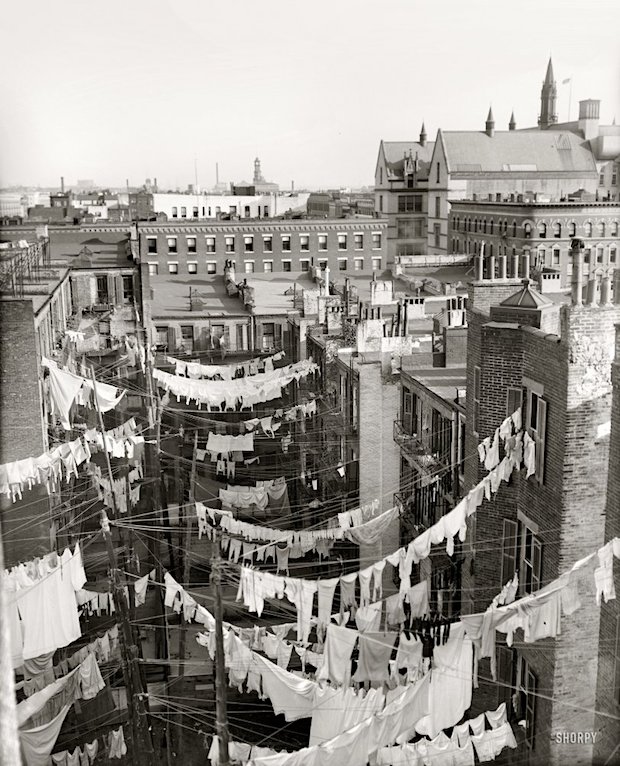
DPC Yard of tenement, Manhattan, New York City 1900

• U.S. reports 37,519 new cases of coronavirus and 2,707 new deaths.
Total of 824,889 cases and 45,042 deaths
• nearly 40,000 new cases reported between Monday 8:30pm local time, and Tuesday at the same time – Johns Hopkins University
• Reported US coronavirus deaths:
8 weeks ago: 0 deaths
7 weeks ago: 9 deaths
6 weeks ago: 31 deaths
5 weeks ago: 111 deaths
4 weeks ago: 704 deaths
3 weeks ago: 3,834 deaths
2 weeks ago: 12,895 deaths
1 week ago: 26,033 deaths
Right now: 45,039 deaths
• Cases-Top 12 States
New York: 251,690
New Jersey: 92,387
Massachusetts: 41,199
Pennsylvania: 34,528
California: 33,261
Illinois: 33,059
Michigan: 32,967
Florida: 27,495
Louisiana: 24,854
Connecticut: 20,360
Texas: 20,196
Georgia: 19,881
• 33 workers at meat processing plant in Minnesota test positive for coronavirus. Plant closed indefinitely.

• Cases 2,573,471 (+ 74,991 from yesterday’s 2,498,480)
• Deaths 178,558 (+ 7,225 from yesterday’s 171,333)

From Worldometer yesterday evening -before their day’s close-
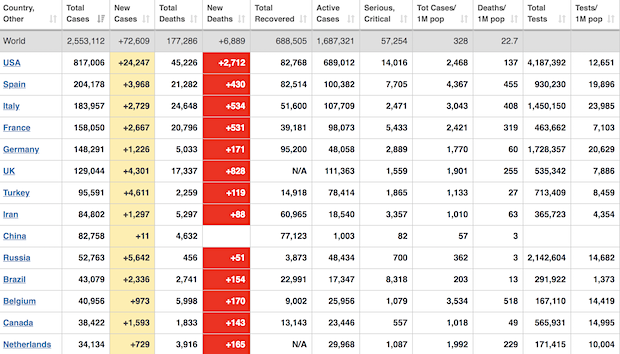
From Worldometer – NOTE: among Active Cases, Serious or Critical fell to 3%. Among Closed Cases, Deaths have fallen to 20%
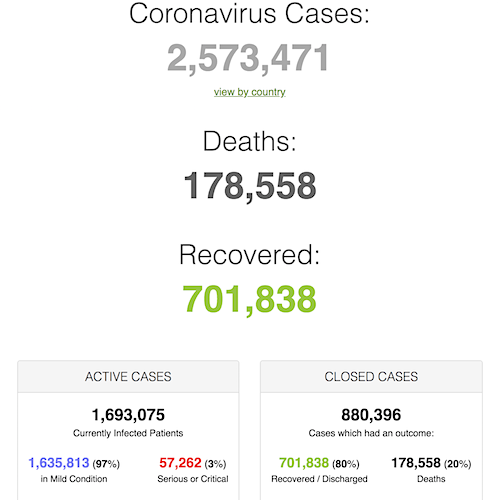
From SCMP:
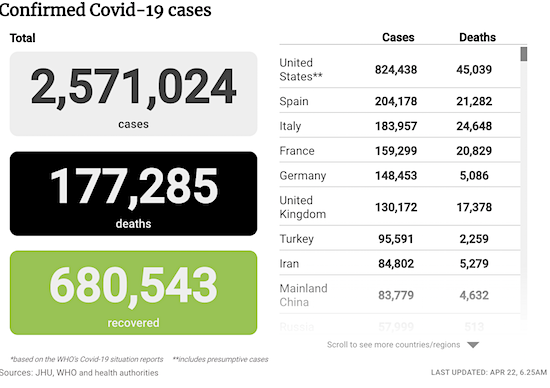
From COVID19Info.live: Note: Turkey, Russia, UK are the biggest risers
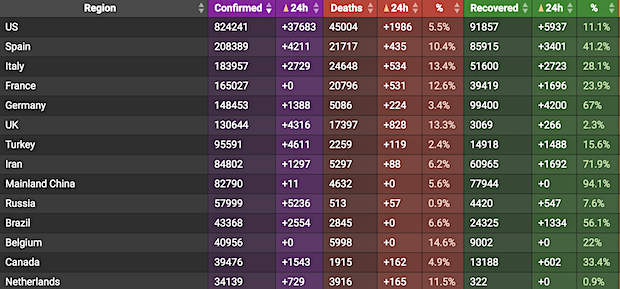

What a relief! Now the US won’t top 1 million cases in April, but only in May. Then again, at 40,000 cases a day like the past 24 hours, forget about that too
• In US COVID19 Can No Longer Be Listed As Primary Cause Of Death (Salon)
George Kelder is CEO and executive director of the New Jersey State Funeral Directors Association, whose members are responsible for dealing with bodies at the hospital, congregant care facilities and private residences. He warns that if we rely solely on official numbers carried on the TV, we may not fully appreciate the lethality of the virus, and indeed may overestimate our success in combating it. In a phone interview, Kelder confirmed that on April 15 New Jersey’s Office of Vital Statistics and Registry, in accordance with the CDC’s National Vital Statistics System, had ordered that deaths of confirmed or suspected COVID-19 patients should no longer be reported with that disease as the immediate cause of death.
“The guidance, available on the New Jersey’s Electronic Death Registration System website, states that COVID-19 is not considered an immediate cause of death and should NOT be reported by the medical certifier on the first line of section 36a (CAUSE OF DEATH, PART I) of the death certificate,” the association advised its members. “Instead, the immediate cause of death, such as “Acute Respiratory Distress Syndrome,” should be listed on the first line. COVID-19 should be listed LAST in Section 36a after the immediate cause(s) has been listed.” “During the five weeks of these fatalities, New Jersey physicians had been instructed to used COVID-19, Coronavirus 19 or ‘pending COVID-19’ as the primary cause of death,” Kelder said.
“Last week, because of changes on the national level, the primary cause of death can no longer be COVID-19. It can be a secondary cause or a consequence of the primary cause of death. But the primary cause of death must be something other than the virus itself.” Kelder observed that pervasive lack of testing, along with this bureaucratic gamesmanship around how COVID-19 deaths are to be classified, could mean that the numbers being used officially “would not be equal to what is happening on the street. “My concern is that we will be getting a false sense of the fatalities based on an administrative and statistical change in reporting,” he said.

This happens everywhere.
• England, Wales COVID19 Death Toll 41% Higher Than Government Figures (FT)
The true death toll from coronavirus in England and Wales up to April 10 was about 41% higher than the UK government’s daily update, according to data released by the country’s Office of National Statistics (ONS). The daily updates on the government’s website only include deaths in hospitals — not other locations, including hospices, care homes and private residences. They also don’t account for the lag in reporting some deaths. The weekly data released by the ONS records deaths where coronavirus is mentioned on the death certificate — even if only suspected. The latest ONS data for deaths up to April 10 (but recorded by April 18) is 13,121.
By comparison, the ONS says the corresponding figure released on the UK government website for England and Wales was 9,288. That’s a difference of 41%. The data also shows the number of coronavirus-related deaths in nursing homes has almost doubled in the five weeks that the ONS has been recording Covid-19 statistics. The total number of deaths registered in England and Wales in the week ending 10 April was 18,516 — the highest weekly total since 2000. The number of deaths in care homes has doubled from four weeks earlier, when the first Covid-19 deaths were registered, and there has been a 72.4% increase in hospitals, and a 51.1% increase in private homes, according to the ONS.
Our weekly deaths data show that
– of all deaths in England and Wales that occurred up to 10 April (registered up to 18 April), 13,121 involved COVID-19
– Comparatively @DHSCgovuk figures show that 9,288 deaths occurred by 10 April https://t.co/g3G5KGuOel #COVID19 #coronavirus pic.twitter.com/0tu6lP9WyT
— Office for National Statistics (ONS) (@ONS) April 21, 2020
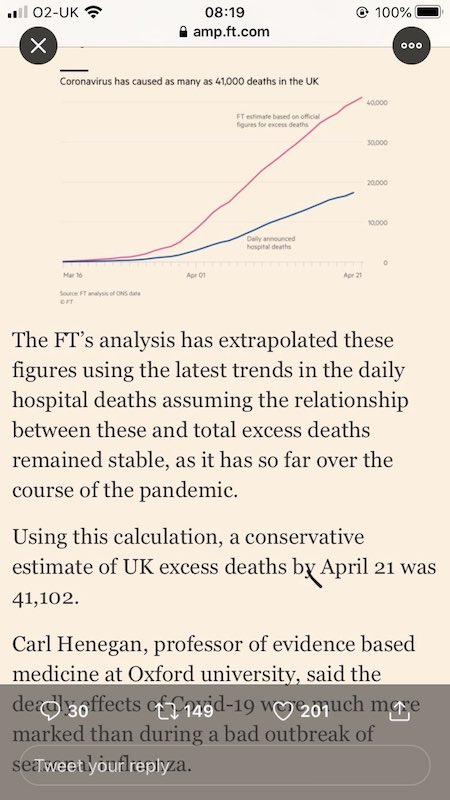
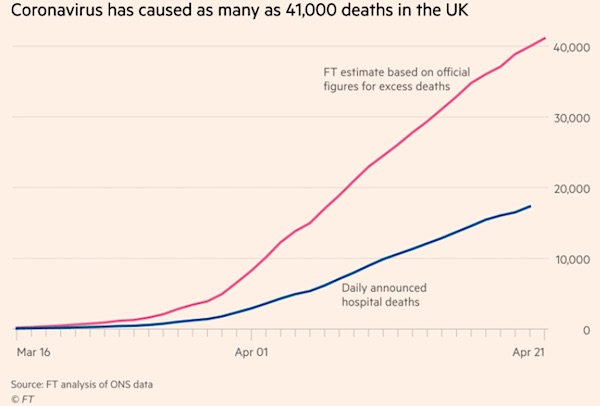
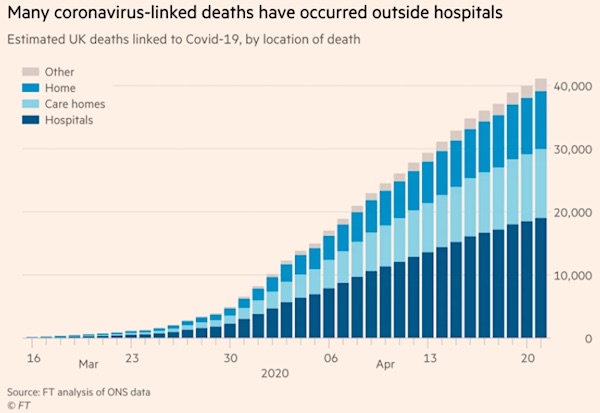

As westerners worry about when to get a haircut…
• UN: Coronavirus Pandemic ‘Will Cause Famine Of Biblical Proportions’ (G.)
The world is facing widespread famine “of biblical proportions” because of the coronavirus pandemic, the chief of the UN’s food relief agency has warned, with a short time to act before hundreds of millions starve. More than 30 countries in the developing world could experience widespread famine, and in 10 of those countries there are already more than 1 million people on the brink of starvation, said David Beasley, executive director of the World Food Programme. “We are not talking about people going to bed hungry,” he told the Guardian in an interview. “We are talking about extreme conditions, emergency status – people literally marching to the brink of starvation. If we don’t get food to people, people will die.”
Covid-19 is likely to be sweeping through the developing world but its spread is hard to gauge. What appears to be certain is that the fragile healthcare systems of scores of developing countries will be unable to cope, and the economic disaster following in the wake of the pandemic will lead to huge strain on resources. “This is truly more than just a pandemic – it is creating a hunger pandemic,” said Beasley. “This is a humanitarian and food catastrophe.” Beasley took his message to the UN security council on Tuesday, warning world leaders that they must act quickly in a fast-deteriorating situation. He urged them to bring forward about $2bn of aid that has been pledged, so it can get to the frontline as quickly as possible.
Another $350m (£285m) is also needed to set up the logistics network to get food and medical supplies – including personal protective equipment – to where it is needed, including air bridges where ground transport is impossible. Even before the Covid-19 crisis, Beasley was appealing to donor countries to up food relief funding to the poorest, because conflict and natural disaster were putting severe strain on food systems. “I was already saying that 2020 would be the worst year since the second world war, on the basis of what we forecast at the end of last year,” he said. Added to that, earlier this year East Africa was hit by the worst locust swarms for decades, putting as many as 70 million people at risk.

Was looking for a better write-up of this, but couldn’t find one. Most comments say this is just posturing since you can’t sue a state, but they’re suing companies and individuals too, and that may work very differently.
• Missouri Is Suing China Over Coronavirus Impacts (CNN)
Missouri is suing the Chinese government and other top institutions for the role they played in the coronavirus pandemic and the effects it has had on the state, accusing the country of covering up information, silencing whistleblowers and doing little to stop the spread of the disease, Missouri Attorney General Eric Schmitt announced Tuesday. At least 6,105 people have been confirmed to have the virus in Missouri and at least 229 have died, according to numbers from Johns Hopkins University Schmitt, in his official role as attorney general of Missouri, filed the civil lawsuit in federal court in the eastern district of Missouri.
The lawsuit, the first of its kind, claims “Chinese authorities deceived the public, suppressed crucial information, arrested whistleblowers, denied human-to-human transmission in the face of mounting evidence, destroyed critical medical research, permitted millions of people to be exposed to the virus, and even hoarded personal protective equipment—thus causing a global pandemic that was unnecessary and preventable.” Legal experts have said the lawsuit faces an uphill battle because China is protected by sovereign immunity. CNN is reaching out to the Chinese government for comment. Missouri’s lawsuit alleges that while the Chinese medical community had indications of human-to-human transmission of the virus, they did not inform the World Health Organization when they first reported the outbreak.
It also alleges Chinese leaders did little to curb spread of the virus, still allowing thousands of people to travel to and out of Wuhan. “In mid-January, on or around January 16, despite knowing the risks of doing so, Wuhan leaders hosted a potluck dinner for 40,000 residents, increasing the potential spread of the virus,” it says. “Defendants allowed these massive public gatherings and massive exodus from Wuhan despite knowing the risks of COVID-19, including the risk of human-to-human transmission.” The filing also outlines how officials initially cracked down on medical professionals who posted information about the virus, including Dr. Li Wenliang, who was accused of rumor-mongering by the Wuhan police after sharing information about a new illness with his medical school alumni group. Wenliang later died of the virus.

Surprised? Me?
• CDC’s Failed Coronavirus Tests Were Tainted With Coronavirus (AT)
As the new coronavirus took root across America, the US Centers for Disease Control and Prevention sent states tainted test kits in early February that were themselves seeded with the virus, federal officials have confirmed. The contamination made the tests uninterpretable, and—because testing is crucial for containment efforts—it lost the country invaluable time to get ahead of the advancing pandemic. The CDC had been vague about what went wrong with the tests, initially only saying that “a problem in the manufacturing of one of the reagents” had led to the failure. Subsequent reporting suggested that the problem was with a negative control—that is, a part of the test meant to be free of any trace of the coronavirus as a critical reference for confirming that the test was working properly overall.
Now, according to investigation results reported by The New York Times, federal officials confirm that sloppy laboratory practices at two of three CDC labs involved in the tests’ creation led to contamination of the tests and their uninterpretable results. Shortly after the problems became apparent in early February, the Food and Drug Administration sent Timothy Stenzel, chief of in vitro diagnostics and radiological health, to the CDC to investigate what was going wrong. According to the Times, he found a lack of coordination and inexperience in commercial manufacturing. Problems that led to the contamination included researchers coming and going from labs working on the test kits without changing their coats and researchers sharing lab space to both assemble test components and handle samples containing the coronavirus.

Or not.
• CDC Chief Warns Second COVID-19 Wave May Be Worse (R.)
A second wave of the coronavirus is expected to hit the United States next winter and could strike much harder than the first because it would likely arrive at the start of influenza season, the director of the Centers for Disease Control and Prevention warned on Tuesday. “There’s a possibility that the assault of the virus on our nation next winter will actually be even more difficult than the one we just went through,” CDC Director Robert Redfield told the Washington Post in an interview. As the current outbreak continues to taper off, as shown by a recent decline in hospitalization rates and other indicators, authorities need to prepare for a probable resurgence in the months ahead. “We’re going to have the flu epidemic and the coronavirus epidemic at the same time,” he said, and the combination would put even greater strain on the nation’s healthcare system than the first outbreak..

The very people who failed the worst get most praise. Stop it. Yeah, they can be good little managers, but that doesn’t excuse them being months late.
• The COVID-Crisis And Leader Approval Ratings (ZH)
Despite the massive impact of the coronavirus crisis in Italy, where over 180 thousand people have so far contracted the virus and 24 thousand people have died, leading to the country’s healthcare system to be catastrophically overwhelmed, its leader Giuseppe Conte is riding an unprecedented wave of popularity. Having Jumped to 71 percent in March, his highest rate since taking office, his approval rating in April is 63 percent – still a whole 11 points higher than his figure for February before the national lockdown was announced.
As Statista’s Martin Armstrong notes, it’s a similar story in the UK too, where Boris Johnson, who spent a couple of nights in intensive care due to Covid-19 himself, is 18 points up on February. This, although his government’s response has been under severe fire in recent weeks due largely to low testing capacity and a drastic lack of PPE for medical staff. Where this coronavirus goodwill ends though is in the United States where the starkly divided population has been unmoved by Donald Trump’s crisis response to cross any of the deeply set party lines. Comparing poll averages in February to those in April show a very modest one-point increase for the president.
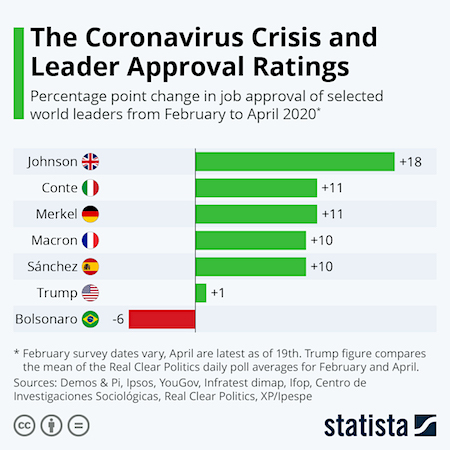

Subtitle: Why Are Planes Still Flying?
• 15 Deaths In US Airline Industry In 9 Days Linked To Coronavirus (LAT)
Somehow, word got around among retired New York City firefighters about a perfect second-career job: a local company, with lots of travel perks. One by one, they became flight attendants at JetBlue. Ralph Gismondi was among the first of an estimated 30 or so former firefighters who joined the airline. He retired as a fire captain after several decades that included a stint at ground zero on 9/11. He began working as a flight attendant for JetBlue in 2003 and saw each trip as a chance to fine-tune his comedy routine over the public address system. On layovers, he would play the piano in hotel lobbies and rally other flight attendants for nights out on the town, coworkers said. On April 5, Gismondi became the first JetBlue employee to die of COVID-19. Within days, two more JetBlue deaths linked to the coronavirus followed.
Pilot Kevin McAdoo, a U.S. Air Force veteran, died April 7. Then, 27-year-old Jared Lovos, a fitness enthusiast who had been a JetBlue flight attendant and recently transferred to human resources, died April 10. Across the industry, The Times learned of at least 15 workers who have died from COVID-19 from April 5-13, according to the airlines, unions and interviews with family members and friends. Yet without any central tracking, the true number of deaths in the airline industry is likely to be significantly higher. An American Airlines gate agent at Los Angeles International Airport, an aircraft mechanic at a Tulsa, Okla., airport, a baggage handler at Dallas-Fort Worth and a food services manager at JFK airport in New York are all counted among the recent dead. And the human toll of air travel is mounting.

No wonder airline staff are dying.
• No Screening For Passengers Arriving At Heathrow From Virus Hotspots (DM)
Even the blue face mask covering the Iranian-British businessman’s face couldn’t conceal his consternation as he emerged into the arrivals hall at Heathrow Airport. Before boarding his Iran Air flight from Tehran, Farzad Parhizkar’s temperature – and those of the other 80 or so passengers – was checked by a laser-beam thermometer, he told me. They had also been obliged to fill in a form giving such details as their name and address, destination, reason for travel, and whether they had any symptoms of coronavirus. ‘Then, when I arrive here in London, there is nothing at all,’ he said, his eyebrows raising above the mask. ‘There was no temperature check, no questions about my health, no advice on how to avoid catching the virus. Nothing. Everything was all just like the world is normal.’
It was a criticism I heard repeatedly at Heathrow yesterday and on Sunday as I spoke to some of the 15,000 travellers who are – by Health Secretary Matt Hancock’s latest estimate – still flying into Britain every day. Of these, the Department for Transport claims about 10,000 are landing at London’s main hub, while others are coming in through Gatwick, Manchester and Birmingham. At a time when the nation is in lockdown, the very fact that these airports remain open to commercial flights is surely questionable enough. That we are continuing to welcome passengers from countries such as Iran, where the official Covid-19 death rate stood yesterday at 5,209 (though many believe the mullahs are lying and that it is considerably higher) seems like utter madness.
Yesterday morning, flights also arrived from New York – the city with the world’s highest number of coronavirus deaths, 13,869 – Los Angeles (California, 1,072 deaths), Chicago (Illinois, 1,290), Miami (Florida, 764), Dallas (Texas, 467) and Washington DC (624). Later, planes were due in from Rome, Madrid and Paris – three capitals at the epicentre of this pandemic – as well as from Tokyo, Lagos, Lisbon and Ahmedabad in India. According to Heathrow’s website, the purpose of keeping the airport open is to help repatriate British citizens and import vital freight, such as medical equipment and food. It points out that traffic has fallen by 75 per cent while cargo has increased by 200 per cent.

If you write on the topic, at least give some examples of countries doing something about it. Plenty to do in Japan.
• The Risks Of Relying On China For Critical Medical Supplies (SCMP)
[..] when Covid-19 spread to the rest of world, policymakers and politicians in the West were faced with a more critical challenge concerning national health, state security and geopolitics, as they all depend on China for critical medical supplies in their life-and-death battles against the lethal pandemic. Most developed economies rely on China to supply products such as personal protective equipment, testing materials, face masks, medicine and pharmaceutical materials. In this pandemic, China’s dominance in some strategically significant sectors, such as the active pharmaceutical ingredient industry, may well serve as a wake-up call for political elites in Washington’s corridors of power and the chancelleries of Europe.
[..] The Covid-19 pandemic is simultaneously a supply-side and demand-side shock, underscoring the potential public health, humanitarian and geopolitical crisis, and exposing flaws in the global system. Economically, countries have become more connected and interdependent. Politically, however, governments rule in totally different ways with different objectives. Yet, Adam Smith’s The Wealth of Nations does not take into account the conflicts of politics, economics among them. Similarly, David Ricardo’s theory of comparative advantage espouses the effectiveness and efficiency of free-market competition, but says nothing about geopolitical rivalry.
Covid-19 comes amid escalating tension and rivalry between US-led alliances and China, given China’s fast-growing clout and Beijing’s pivot towards greater authoritarian rule domestically and a greater assertiveness internationally in the past decade or so. The pandemic has served to convince policymakers and strategists in the West not only of the economic risk of their over-reliance on a single country for critical supplies, but also the geopolitical risk of relying on a nation they call a “strategic rival”. Covid-19 will undoubtedly hasten the efforts of Western nations to not only diversify their supply sources to reduce economic risks, but also to diversify away from China to reduce the national security and geopolitical hazards.

As American as apple pie. Pelosi’s go-to girl for the bailouts. “We’re after fraud.”
• Donna Shalala Failed To Disclose Stock Sales In 2019 (MH)
Miami Democratic Rep. Donna Shalala, the lone House Democrat on the committee set up to oversee $500 billion in taxpayer money being used for coronavirus-related payouts to large businesses, violated federal law when she failed to disclose stock sales while serving in Congress. Shalala told the Miami Herald on Monday she sold a variety of stocks throughout 2019 to eliminate any potential conflicts of interest after she was elected to Congress in November 2018. But the transactions were not publicly reported as required by the STOCK Act, a 2012 law that prohibits members of Congress and their employees from using private information gleaned from their official positions for personal benefit and requires them to report stock sales and purchases within 45 days. Shalala’s office said the congresswoman and her financial adviser made a mistake.
Shalala, the former head of the Department of Health and Human Services under President Bill Clinton, is in the process of setting up a blind trust for her assets, and transactions made within a blind trust without a lawmaker’s knowledge are not required to be disclosed. But the blind trust isn’t finalized, meaning any transactions would need to be made public. “She had a misunderstanding about the periodic transaction report process and her need to report the sale of these stocks while preparing a blind trust,” Shalala spokesperson Carlos Condarco said. “As a new member with a broker and attorney who were not familiar with the congressional disclosure rules, there was a misunderstanding.” Shalala acknowledged the transactions after she was selected by House Speaker Nancy Pelosi to represent House Democrats on a bipartisan panel that will monitor $500 billion in payouts to large businesses affected by the coronavirus.
On her 2018 financial disclosure, the most recent that is publicly available, Shalala said she owned a number of stocks in companies that could be eligible to seek federal bailouts, a potential conflict of interest. Shalala’s appointment to the five-person commission put her in the role of helping to supervise efforts by the U.S. Treasury Department and the Federal Reserve to stabilize the economy by lending hundreds of billions of dollars to struggling businesses, hospitals, municipalities and states. It will hold hearings and issue monthly reports to Congress. “Treasury got a huge pot of money to bail out large industries, specifically airlines,” Shalala said, of her role on the committee. “What we’re really after is mischief. We’re after fraud.”

Actually, it wasn’t the banks, it was their execs. So sue them.
• Lawsuit Claims 10 Big Banks Rigged Market For ‘Odd-Lot’ US Corporate Bonds (R.)
Ten of the world’s largest banks, including JPMorgan Chase and Bank of America, have been sued for allegedly conspiring over nearly 14 years to rig prices in the $9.6 trillion U.S. corporate bond market, costing ordinary investors billions of dollars. The proposed class action filed on Tuesday in federal court in Manhattan said the banks have since August 2006 violated antitrust law by overcharging investors on “odd-lot” trades, which are worth less than $1 million and comprise 90% of all corporate bond trading. Other defendants include Barclays, Citigroup, Credit Suisse, Deutsche Bank, Goldman Sachs, Morgan Stanley, Royal Bank of Scotland and Wells Fargo & Co, or their respective affiliates.
According to the 81-page complaint, the banks leveraged their power from handling more than two-thirds of U.S. corporate bond underwriting to quietly inflate spreads between the prices where they would buy and sell odd-lot bonds. This allegedly resulted in spreads 25% to 300% higher than on “round-lot” trades over $1 million, which are normally conducted by institutional investors, enabling the banks to reap higher compensation while boosting retail investors’ trading costs. “No reasonable economic justification explains the magnitude of the pricing disparity,” the complaint said. It added that odd-lot spreads are narrower even in foreign bond markets with lower volumes and liquidity.

We would like to run the Automatic Earth on people’s kind donations. Since their revenue has collapsed, ads no longer pay for all you read, and your support is now an integral part of the process.
Thanks for your generousl donations to date.


https://twitter.com/i/status/1129481220289642502

Support the Automatic Earth. It’s good for your mental health.








Home › Forums › Debt Rattle April 22 2020